Seema Bansal, Shalini Sud
Department of Master of Design, National Institute of Fashion Technology, New Delhi, India
Correspondence to: Seema Bansal, Department of Master of Design, National Institute of Fashion Technology, New Delhi, India.
| Email: |  |
Copyright © 2017 Scientific & Academic Publishing. All Rights Reserved.
This work is licensed under the Creative Commons Attribution International License (CC BY).
http://creativecommons.org/licenses/by/4.0/

Abstract
To study the emergence of the new field of technology in the domain of fashion, also referred as ‘wearable technology’ and then code and decode the cross between fashion and technology from multiple perspectives.
Keywords:
Science, Technology, Textile, Fashion, Design, Wearable tech, Wearable art
Cite this paper: Seema Bansal, Shalini Sud, Advancement and History of Techno Fashion, International Journal of Arts, Vol. 7 No. 2, 2017, pp. 33-37. doi: 10.5923/j.arts.20170702.02.
1. Introduction
The intersection of design, fashion, science and technology paves the way for a new era in which fashion acquires contemporary forms of functionality. The concept of embedding nanotechnology into wardrobe contributes to the intensification of the union of body and technology. It was fashion journalist Bradley Quinn, who coined the term ‘Techno Fashion’ in 2002 by publishing book. Information and Communication Technologies are an extension of the human body and mind, and they have the ability to alter the way we relate to ourselves, to our environment and to each other. As the dialogues between clothing and machine are getting reconfigured, a generation of designers-cum-scientists is breeding who practice technology to probe new territories and directions. Their work is also shifting the accepted fashion vocabulary from sewn or manufactured to engineered.
2. History
If past two centuries are looked over critically, then it can be observed that history of fashion itself can be considered to be history of technology. The design techniques used for the manufacturing corsets and soldier uniforms, were considered as technical innovations. Bradley Quinn traces the origin of wearable technology back to the 1939, when American designer Gilbert Rohde designed the solo-suit which was embedded with metal wire that regulated body temperature and made the fabric change color accordingly (Florea, 2012). Rohde’s suit envisaged future of streamline efficiency as he made the garment functional and also introduced special crease-proof fabric that repelled dirt and had long zips instead of buttons.Alike projects within the umbrella of futuristic designs were halted by the outbreak of second World War, but as the Space program gained momentum in America, clothing and technology merged in the development of space suit in 1960s. The principle of spacesuit revived optimism as it suggested that clothing could perform unthinkable tasks of penetrating unexplored environments and survive in a portable microcosm (Quinn, 2002) that could carry through worlds. 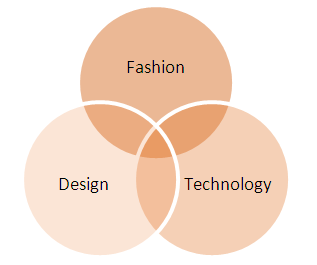 | Figure 1. Intersection of fashion, design and technology |
By 1980s and 1990s, conglomeration of architecture, furniture, technology and design was practiced by designers like Lucy Orta collapsing the traditional boundaries. Thereafter, the techno fashions integrate technology in clothing to perform range of profound implications for body, health, lifestyle etc.
3. Technology
The domain of wearable technology is decentralized and its agents are dispersed across all imaginable and unimaginable fields. Now it is not wrong to say that 0 and 1 binary logic of computer circuitry correspond to thread-up and thread-down of the weaving process.The conventional ways have been revolutionized to the level of printing the whole wardrobe at home.Today, fashionable wearables are the pendulum idea between information and amplifiers of fantasy. Fashionable wearables vary in levels of expressiveness versus functionality (Table 1).Table 1. Font Range of fashionable wearables
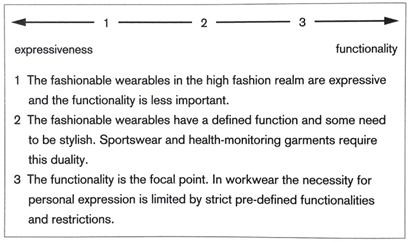 |
| |
|
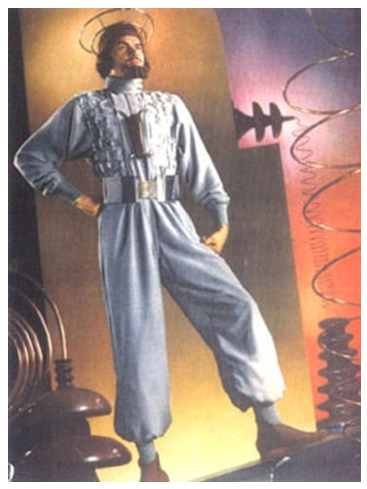 | Figure 2. Solo-suit (Source: Floreo, 2012) |
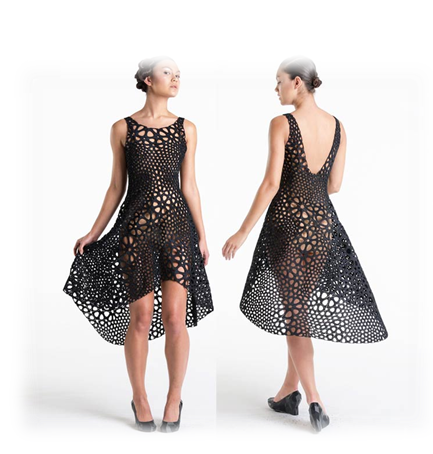 | Figure 3. 3D printed dress (Source: Mia, 2014) |
3.1. Communication
When the population was small in number and technological means of appropriating resources were limited, there was less impact of societal actions. But now, the population is numbered in billions and has enormous capacity of exploring technology coupled with economy appetite, there is immediate feedback over every action achieved by wireless communication.The ability to hand out data from a system attached to the body was a major turning point in the development of wearables. Functionality was no longer just the mere protection of body by fabric, techno fashion treated contemporary matters based on societal observations.Many celebrities now-a-days carry techo fashion wears in their live concerts to stand out and grab attention like Lady Gaga, Jennifer Loez.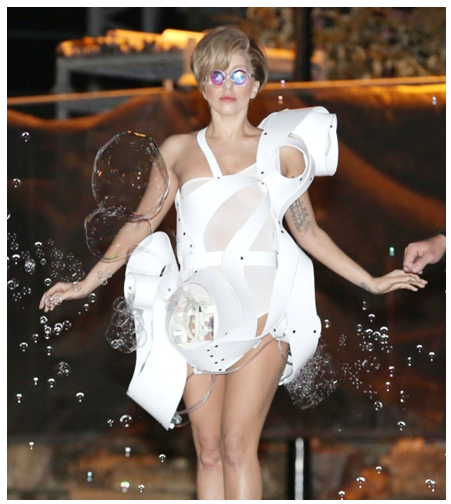 | Figure 4. Lady Gaga in stunning techno fashion clothing |
 | Figure 5. Jennifer Lopez’s giant princess gown as projector screen |
3.2. Issues
Interdisciplinary: Emergence of techno fashion demands for extensive collaboration of scientists, designers and technologists. Movements like ‘technocraft’ and ‘DIY’ have combined various disciplines and cultivated the beginning of interdisciplinary collaborations.Life Cycle: Fashion and technology celebrate different life cycles. An electronic device may have a life span of 2-3 years on the other hand a clothing might be disposed off after a couple of seasons. Thus making a workable integration is a challenging proposition.Health: The health issues associated due to electromagnetic frequency, wireless communication, and battery leakage problems are still point of controversies.
3.3. Space Age
The space suit critically highlighted techno fashion, giving the body control over technology, effectively making technology inseparable part of body’s system. Space-age fashion relied heavily on exploring high-performance textiles like Gore-tex, Teflon, Nylon and Mylar. These materials were made shiny and silvery by coating them with Aluminum. Silver and metallic finish became very characteristic of space-age look. Later the materials were altered with vinyl, Lucite, polystyrene, acrylic and polyvinyl chloride, as they were much comfortable to skin as well as easier to be worked with. The famous classic Star Trek series was representative of fashion’s future vision whereas simple tunics were installed with wireless communication devices.Futurism associated with space age gave perfect antidote to the fashion of early 1960s. Emanating from London, this style voiced a message of dissatisfaction with social structure and thus was dominated by youth culture, street style and mod fashion to show resistance to convention. Paris, the traditional center of fashion, was completely lacking to compete in this area. Later, French fashion designers explored futurism as style for youth and thus space-age became more of a metaphor for the youth, charging fashion with optimism. In Paris, young wanted to breakaway from couture, and contemptuously stated, “Couture is for grannies.”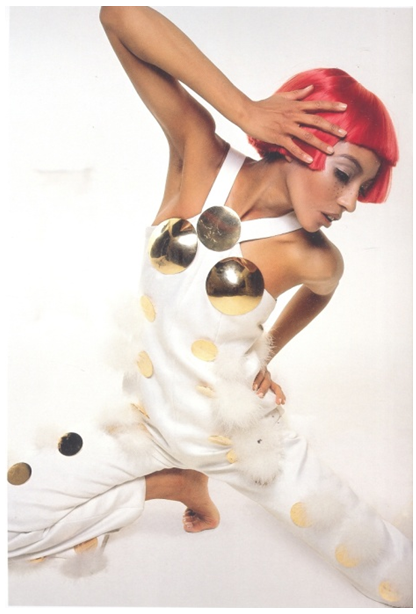 | Figure 6. Source Fashion Book, 2000 |
As a result, French couture redefined itself to resonate with youth revolution. Andre Courreges, Yves Saint Laurent, Pierre Cardin and Paco Rabanne are the designers who pioneered the space-age look in their designs and encapsulated the imagery for future as: intelligent, avant-garde, progressive and thoroughly modern. Asymmetric zips, steel belts, silver buckles, metallic fabrics riveted with metal studs were exquisitely made to create utilitarian look.
4. Embedded Technology
The incorporation of technology depends on both the surrounding environment and context of use. Embedded technologies encourage the wearability, comfort and aesthetics of techno fashion. The required interaction sought from wearable tech can be consciously controlled by biometric data collected from body and automatic data feeds from environment (Table 2).Table 2. Active input for wearable tech
 |
| |
|
4.1. Technical Sensors
Body-sensing technologies integrated into textiles through which physical and emotional states are effectively captured through changing properties of epidermis. The actuators generate the corresponding response by producing specific kind of output (Technical Textiles International, 2000).
4.2. Embedded Sensors
Many fashionable wearables use conventional sensors to gather data. These sensors can measure data types ranging from proximity to smell. The data is fed as input to the microprocessor chip to compute and perform.Outputs can stimulate any of the five senses of the wearer or the audience. The options are endless and vary with the requirement (Table 3).Table 3. Outputs to address specific senses
 |
| |
|
5. Materials
The use of enhanced materials in conjunction with current research in biotechnologies, nanotechnology and digital technologies lead to marriage of essential function and aesthetic design. Technically enhanced textiles are the enablers for innovative in the field of fashionable technology. An electronic textile is the one that can incorporate capabilities like sensing (biometric or environmental), communication (wireless), and power transmission essential for functionality. The processing of data through microprocessors on the body requires energy that is primarily constituted by batteries. However it cannot be denied that battery life’s limited and therefore developers and designers look for alternative sources of energy that allows computation reliably.An interesting alternative energy source for intelligent clothing is devised as the human body itself, which generates power through human body kinetics or fluctuations in body temperature (Fry, 2009). | Figure 7. Source Fashion Book, 2000 |
5.1. Garment Construction
While design wearable tech fashion, factors like comfort, durability and aesthetics are very essential. Thus designers have to have the comprehensive understanding of the user, purpose, application and the right price. Engineering of the fashionable wearable is influential of many considerations for construction (Table 4).Table 4. Design construction for fashionable wearables
 |
| |
|
Garment interfaces: Interaction of the wearer with conductive metal-based buttons, hooks and zippers have become intuitive and can be modified into switches to open or close the electronic circuit.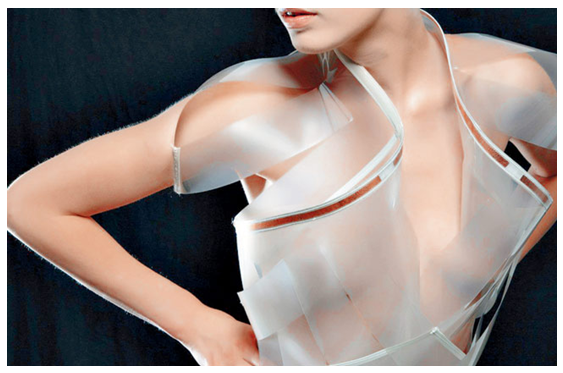 | Figure 8. Heartbeat sensor integrated color changing dress |
6. Conclusions
Techno Fashion when seen through the prism of the current zeitgeist, it is not wrong to characterize it as apocalyptical. The current society is very much outlined as being problem-ridden and thus demands solutions to its myriads of contemporary issues. Techno Fashion is seen as optimal platform for implementing much-needed solutions. In this respect, wearable tech is viewed as enrtrance of mankind into its next evolutionary stage called posthumanism. It is the merger of technology and the human body that creates a positive apocalypticism. Techno Fashion’s problem-solving capabilities give rise to a hope for a better tomorrow. This hope in itself is one of the solutions for today’s problem-oriented society (Barthes, 2005).Regardless of how radical the revolution will be within both humanity and technology, optimism can be drawn from Antoine Lavoisier, the father of modern chemistry who has said: Rien ne se perd, rien ne se crée, tout se transforme. (Nothing is lost, nothing is gained, everything merely transforms) (Florea, 2012).
References
| [1] | Florea, A.C., 2012. Techno Fashion: a Cultural Revolution at the Intersection of Fashion and Technology in the Age of Apocalypticism. Denmark: Aarhus University. |
| [2] | Quinn, B., 2002. Techno Fashion. New Yorek: Oxford Publication. |
| [3] | Technical Textiles International, 2000. Technical Textiles International. January. |
| [4] | Fry, T., 2009. Design Futuring. London: Bloomsburg Academic Publishing Ltd. |
| [5] | Barthes, R., 2005. The Language of Fashion. London: Bloomsburg Publishing Ltd. |
| [6] | Steele, V., 2010. The Berg Companion to fashion. 2010, New York, USA: Berg Publishers. |
| [7] | Lovinski, N.P., 2010. The world's most influential Fashiopn Designer. London: A&C Black Publishers. |
| [8] | Fischer, V., 1989. Design Now. Germany, Munich: Prestel Verlag. |
| [9] | Modernism, N.m.r.-G.D.a.P., 2000. Rick Poynor. |
| [10] | Fashion, 2000. Charlotte Seeling. Om Books International. |
| [11] | Technology, F., 2008. Sabine Seymour. New York: Springer Wein Publisher. |
| [12] | Steinberg, D., n.d. Technology Meets Fashion When Look Solutions' TINY CX Fog Generator Triggers Designer Anouk Wipprecht's Smoke Dress. [Online] Available at: HYPERLINK "https://0x9.me/vy8PX" https://0x9.me/JZId7 [Accessed 20 September 2015]. |
| [13] | REPORTER, M., n.d. Jennifer Lopez wears giant princess gown as she debuts new ballad Fell the Light during American Idol performance. [Online] Available at: HYPERLINK "https://0x9.me/DVIU4" https://0x9.me/4SsTH [Accessed 19 September 2015]. |











 Abstract
Abstract Reference
Reference Full-Text PDF
Full-Text PDF Full-text HTML
Full-text HTML


